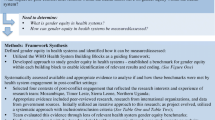Abstract
Gender inequities in health prevail in most countries despite ongoing attempts to eliminate them. Assessment of gender-sensitive health policies can be used to identify country specific progress as well as gaps and issues that need to be addressed to meet health equity goals. This study selected and measured the existence of gender-sensitive health policies in a low- (Peru), middle- (Colombia), and high (Canada)-income country in the Americas. Investigators selected 10 of 20 gender-sensitive health policy indicators and found eight to be feasible to measure in all three countries, although the wording and scope varied. The results from this study inform policy makers and program planners who aim to develop, improve, implement, and monitor national gender-sensitive health policies. Future studies should assess the implementation of policy indicators within countries and assess their performance in increasing gender equity.
Similar content being viewed by others
References
Beck, T. (1999) Using Gender-sensitive Indicators: A Reference Manual for Governments and Other Stakeholders. London: Commonwealth Secretariat.
Phillips, S. (2005) Defining and measuring gender: A social determinant of health whose time has come. International Journal for Equity in Health 4 (1): 11.
Doyal, L. (2001) Sex, gender, and health: The need for a new approach. British Medical Journal 323 (7320): 1061–1063.
Grace, S.L., Fry, R., Cheung, A. and Stewart, D.E. (2004) Cardiovascular disease. BMC Womens Health 4 (1): S15.
Garcia-Moreno, C., Heise, L., Jansen, H.A., Ellsberg, M. and Watts, C. (2005) Public health. Violence against women. Science 310 (5752): 1282–1283.
Doyal, L. (2000) Gender equity in health: Debates and dilemmas. Social Science & Medicine 51 (6): 931–939.
Doyal, L. (2003) Sex and gender: The challenges for epidemiologists. International Journal of Health Services 33 (3): 569–579.
Kessler, R.C. (2003) Epidemiology of women and depression. Journal of Affective Disorders 74 (0165–0327; 1): 5–13.
Case, A. and Paxson, C. (2005) Sex differences in morbidity and mortality. Demography 42 (2): 189–214.
Garcia-Moreno, C., Jansen, H.A., Ellsberg, M., Heise, L., Watts, C.H. and WHO Multi-country Study on Women's Health and Domestic Violence against Women Study Team (2006) Prevalence of intimate partner violence: Findings from the WHO multi-country study on women's health and domestic violence. Lancet 368 (9543): 1260–1269.
Garcia-Moreno, C. (2002) Dilemmas and opportunities for an appropriate health-service response to violence against women. Lancet 359 (9316): 1509–1514.
Sen, G. and Ostlin, P. (2008) Gender inequity in health: Why it exists and how we can change it. Global Public Health 3 (S1): 1.
Pan American Health Organization (PAHO). (2005) Gender, Health, and Development in the Americas: Basic Indicators 2005, http://www.paho.org/Project.asp?SEL=HD&LNG=ENG&10=378, accessed 5 October 2009.
Pan American Health Organization (PAHO). (2001) Health indicators: Building blocks for Health Situation Analysis. Epidemiological Bulletin 22 (4), http://www.paho.org/English/dd/ais/eb_v22n4.pd, accessed 5 October 2009.
Moss, N.E. (2002) Gender equity and socioeconomic inequality: A framework for the patterning of women's health. Social Science and Medicine 54 (5): 649–661.
Theobald, S., Tolhurst, R., Elsey, H. and Standing, H. (2005) Engendering the bureaucracy? Challenges and opportunities for mainstreaming gender in Ministries of Health under sector-wide approaches. Health Policy Plan 20 (3): 141–149.
Lin, V., L’Orange, H. and Silburn, K. (2007) Gender-sensitive indicators: Uses and relevance. International Journal of Public Health 52: S27.
Lin, V., Gruszin, S., Ellickson, C., Glover, J., Silburn, K., Wilson, G. and Poljski, C. (2007) Comparative evaluation of indicators for gender equity and health. International Journal of Public Health 52 (1): S19–S26.
Braveman, P.A. (2003) Monitoring equity in health and healthcare: A conceptual framework. Journal of Health Population and Nutrition 21 (3): 181–192.
Pan American Health Organization (PAHO). (2005) Basic indicators for gender equity analysis in health. 2005, 1–152, http://www.bvsde.paho.org/bvsacd/cd20/basicindicators.pdf, accessed 5 October 2009.
Canadian Institutes of Health Research. (2008) Global health – Healthy Canadians in a healthy world. Gender and Health, 13 March, http://www.cihr-irsc.gc.ca/e/35878.html, accessed 26 August 2009.
World Health Organization Centre for Health Development. (2004) Gender perspective for better health and welfare systems development. Proceedings of the Fourth International Meeting on Women and Health World Health Organization Centre for Health Development, 2004, Kobe, Japan, 1–140, http://www.who.or.jp/library/0370_p.pdf, accessed 5 October 2009.
Lin, V. et al (2003) Comparative evaluation of indicators for gender equity and health, 1–332, http://www.who.or.jp/library/tf1_report.pdf, accessed 5 October 2009.
Hospital Report Research Collaborative. (2001) Hospital Reports 2001: Preliminary studies, Vol. 2 – Exploring Nursing, Women's Health, Population Health, http://www.hospitalreport.ca/downloads/2001/prelim_studies_vo2.pdf, accessed 5 October 2009.
International Labour Organization (ILO). (2000) Trade unions and the informal sector: Towards a comprehensive strategy. Geneva, ILO Bureau of Worker's Activities (ACTRAV), http://www.ilo.org/public/english/dialogue/actrav/publ/infsectr.htm, accessed 5 October 2009.
Canadians for Choice. (2006) Reality check: A close look at accessing abortion services in Canadian hospitals, Ottawa: Canadians for choice, 1–62, http://www.canadiansforchoice.ca/report_english.pdf, accessed 5 October 2009.
Acknowledgements
We thank the Canadian Institutes of Health Research, Institute of Gender and Health for support for this study.
Author information
Authors and Affiliations
Additional information
Gender inequities in health prevail in most countries despite ongoing attempts to eliminate them. The authors review gender-sensitive health policies in 3 countries to learn about country specific progress – and about how to assess issues to be addressed to meet health equity goals worldwide.
Rights and permissions
About this article
Cite this article
Stewart, D., Dorado, L., Diaz-Granados, N. et al. Examining gender equity in health policies in a low- (Peru), middle- (Colombia), and high- (Canada) income country in the Americas. J Public Health Pol 30, 439–454 (2009). https://doi.org/10.1057/jphp.2009.40
Published:
Issue Date:
DOI: https://doi.org/10.1057/jphp.2009.40




